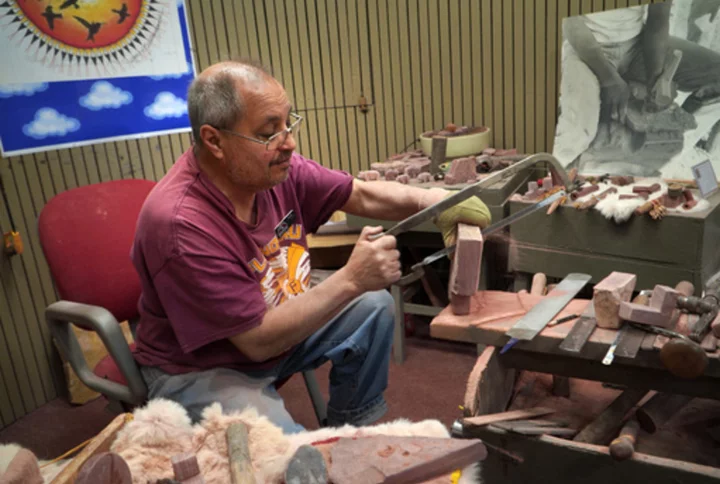PIPESTONE, Minn. (AP) — Under the tall prairie grass outside this southwestern Minnesota town lies a precious seam of dark red pipestone that, for thousands of years, Native Americans have quarried and carved into pipes essential to prayer and communication with the Creator.
Only a dozen Dakota carvers remain in the predominantly agricultural area bordering South Dakota. While tensions have flared periodically over how broadly to produce and share the rare artifacts, many Dakota today are focusing on how to pass on to future generations a difficult skillset that’s inextricably linked to spiritual practice.
“I’d be very happy to teach anyone … and the Spirit will be with you if you’re meant to do that,” said Cindy Pederson, who started learning how to carve from her grandparents six decades ago.
Enrolled in the Sisseton-Wahpeton Dakota Nation, she regularly holds carving demonstrations at Pipestone National Monument, a small park that encompasses the quarries.
In the worldview of the Dakota peoples, sometimes referred to as Sioux, “the sacred is woven in” the land where the Creator placed them, said Iyekiyapiwin Darlene St. Clair, a professor at St. Cloud State University in central Minnesota.
But some places have a special relevance, because of events that occurred there, a sense of stronger spiritual power, or their importance in origin stories, she added.
These quarries of a unique variety of red pipestone check all three – starting with a history of enemy tribes laying down arms to allow for quarrying, with several stories warning that if fights broke out over the rare resource, it would make itself unavailable to all.
The colorful prayer ties and flags hung from trees alongside the trails that lead around the pink and red rocks testify to the continued sacredness of the space.
“It was always a place to go pray,” said Gabrielle Drapeau, a cultural resource specialist and park ranger at the monument who started coming here as a child.
From her elders in the Yankton Sioux Tribe of South Dakota, Drapeau grew up hearing one of many origin stories for the pipestone: In time immemorial, a great flood killed most people in the area, their blood seeping into the stone and turning it red. But the Creator came, pronounced it a place of peace, and smoked a pipe, adding this is how people could reach him.
“It’s like a tangible representation of how we can connect with Creator,” Drapeau said. “All people before you are represented in the stone itself. It’s not just willy-nilly stone.”
Pipes are widely used by Indigenous people across the Great Plains and beyond, either by spiritual leaders or individuals for personal prayer for healing and thanksgiving, as well as to mark rites of passage like vision quests and the solemnity of ceremonies and gatherings.
“Pipestone has a particular relationship to our spiritual practice – praying with pipes, we take very seriously,” St. Clair said.
The pipe itself is thought to become sacred when the pipestone bowl and the wooden stem are joined. The smoke, from tobacco or prairie plants, then carries the prayer from a person’s heart to the Creator.
Because of that crucial spiritual connection, only people enrolled in federally recognized tribes can obtain permits to quarry at the monument, some traveling from as far as Montana and Nebraska. Within tribes, there’s disagreement over whether pipes should be sold, especially to non-Natives, and the pipestone used to make other art objects like carved animal figures.
“Sacredness is going to be defined by you — that’s between you and the Creator,” said Travis Erickson, a fourth-generation carver who’s worked pipestone in the area for more than two decades and embraces a less restrictive view. “Everything on this Earth is spiritual.”
His first job in the quarries, at age 10, was to break through and remove the layers of harder-than-steel quartzite covering the pipestone seam – then about six feet down, now more than 18 feet into the quarry, so the process can take months. Only hand tools can be used to avoid damaging the pipestone.
Taken out in sheets only about a couple of inches thick, it is then carved using flint and files.
“The stone talks to me,” added Erickson, who has fashioned pipe bowls in different shapes, such as horses. “Most of those pipes showed what they wanted to be.”
Growing up in the 1960s, Erickson recalled making pipes as a family affair where the day often ended with a festive grilling. He taught his children, but laments that few younger people want to take up the arduous job.
So does Pederson, some of whose younger family members have shown interest, including a granddaughter who would hang out in her workshop starting when she was 3 and emerge “pink from head to toe” from the stone dust.
But they believe the tradition will continue as long as they can share it with Native youth who might have their first encounter with this deep history on field trips to the monument.
On a recent trip, Pederson’s brother, Mark Pederson, who also holds demonstrations at the visitor center, took several young visitors into the quarries and taught them how to swing sledgehammers — and many asked to return, she said.
Teaching the techniques of quarrying and carving is crucially important, and so is helping youth develop a relationship with the pipestone and its place in the Native worldview.
“We have to be concerned with that as Dakota people – all cultural messages young people get draw away from our traditional lifeways,” St. Clair said. “We need to hold on to the teachings, prayers, songs that make pipes be.”
From new exhibits to tailored school field trips, recent initiatives at the monument — undertaken in consultation between tribal leaders and the National Park Service — are trying to foster that awareness for Native youth.
“I remind them they have every right to come here and pray,” Drapeau said — a crucial point since many Native spiritual practices were systematically repressed for decades past 1937, when the monument was created to preserve the quarries from land encroachment.
Some areas of the park are open only for ceremonial use; the 75,000 yearly visitors are asked not to interfere with the quarriers.
“The National Park Service is the newcomer here — for 3,000 years, different tribal nations have come to quarry here and developed different protocols to protect the site,” said park superintendent Lauren Blacik.
One change brought through extensive consultations with tribal leaders is the park’s decision to no longer sell pipes at the visitor center, though other pipestone objects are — like small carved turtles or owls. Pipes are available at stores a few miles away in Pipestone’s downtown.
Tensions over the use of sacred pipes by non-Natives long predates the United States, when French and English explorers traded them, said Greg Gagnon, a scholar of Indian Studies and author of a textbook on Dakota culture.
“Nobody wants to have their world appropriated. The more you open it up, the more legitimate a fear of watering it down,” he said. But there’s also a danger in becoming entrenched in dogmatic ways of understanding traditions, Gagnon added.
For carvers like Pederson, good intentions and the Spirit at work in both those practicing the craft as well as those receiving the pipestone are reasons to be optimistic about the future.
“Grandma and Grandpa always said the stone takes care of itself, knows what’s in a person’s heart,” she said.
——
Associated Press religion coverage receives support through the AP’s collaboration with The Conversation US, with funding from Lilly Endowment Inc. The AP is solely responsible for this content.









